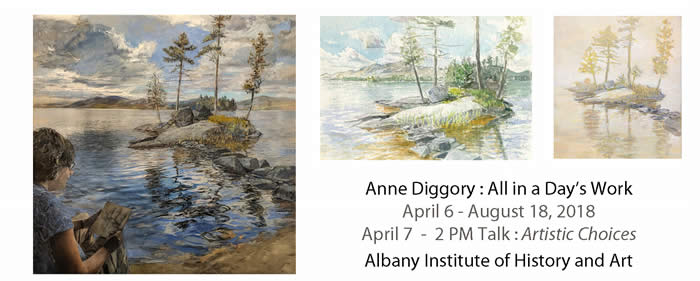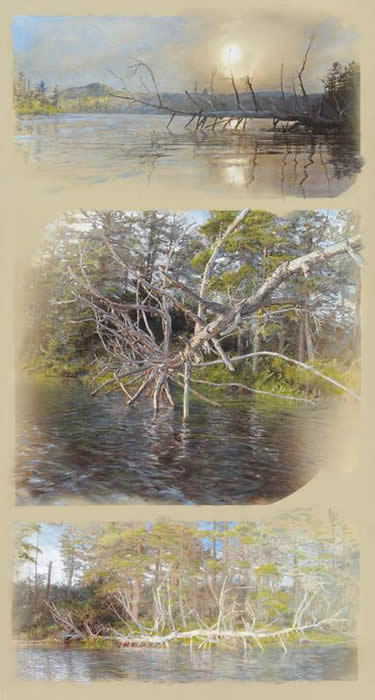| |
|
|
|
 |
 |
|
 |
|
 |
|
 |
|
 |
|
 |
|
 |
|
Albany Institute of History and Art
125 WASHINGTON AVENUE ALBANY, NY

Artist Anne Diggory paints nature’s multiple expressions in the context of both contemporary and historic approaches such as the Hudson River School. The exhibition features sixteen lakeside landscapes, the products of Diggory’s intense concentration on a motif that often yields several works from a single day on location. Rather than choosing just one expression of shifting light and constantly changing patterns of waves and clouds, she creates multiple versions on the spot and later in her Saratoga Springs studio. Six works will focus on a day at Crane Point on Blue Mountain Lake and four on a day on Recluse Island on Lake George. The different artistic choices of medium, palette, amount of detail, and composition are both intuitive and deliberate as each artwork separately expresses the transitory quality of her experience. Diggory’s work, Out of Place at Huletts Landing, directly links her day at Lake George with the portrayal of the same location by the nineteenth-century artist David Johnson and his Study of Nature, Dresden, Lake George (1870), on view in the Institute’s Hudson River School exhibition.
At 2pm on Sunday April 7, Anne Diggory will discuss artistic choices in her own work as well as in those of 19th century painters David Johnson and John Frederick Kensett, whose motifs are included in several pieces in the exhibition. The lecture will be followed by reception with light refreshments and a viewing of the exhibition.
The Institute is organizing a chartered boat cruise on Lake George for June 24th, guided by Anne Diggory. We will cruise along the lake stopping at specific sites painted by Hudson River School artists John Frederick Kensett, David Johnson, and Asher B. Durand as well as Diggory. More details will follow.
 A series of artworks based on the view from Crane Point on Blue Mountain Lake began with three paintings created within 24 hours. In the late afternoon of September 15, 2018, I painted a watercolor of the small island just offshore, beckoning as a visual retreat.
A series of artworks based on the view from Crane Point on Blue Mountain Lake began with three paintings created within 24 hours. In the late afternoon of September 15, 2018, I painted a watercolor of the small island just offshore, beckoning as a visual retreat.
Crane Point 1, 7.5 x 10.25”, watercolor, 2018

Early the next morning the fog obscured all except the island. I chose a vertical format in order to include more of the water and reflections.
Crane Point 2, 10x8”, acrylic on panel 2018

I left for a few hours to take down my nearby exhibition and returned for the mid-day light. I chose to include more of the warmth of the beach at my feet and the beginning of fall colors in the distance.
Crane Point 3, 10x10“, acrylic on panel, 2018
Two months later, back in the studio, I decided to try a larger version (24x24”), with a different approach to the sky and reflections. I had strong memories and photographs of a time when the sky opened up in the middle, changing the whole experience of the space.
Crane Point 4, 24x24”, acrylic on canvas

In the late afternoon back in September,as I was preparing to leave, a series of darkening clouds dominated the scene. The visual memory had haunted me with the contrasts of dark and light and the quickness with which everything changed. I decided to create two more images of the location to emphasize that passage of time. As I often do with my hybrid works, I combined photographs of my artwork with photographs of the scene, merged them in photoshop and had them printed for further painting. Each combines different parts of my experience. Crane Point 5 sets up a contrast between the backlit, dark cloud of late afternoon and the cast shadows of morning. Crane Point 6 was an experiment - what would happen to the dynamics of the scene if I put myself in, based on a photograph of me at the shore, working on the foggy painting after the sun had come out. I always feel that I am inside my artwork and this was chance to be playful with that idea.
Crane Point 5, 24x24” hybrid on canvas, 2019 Crane Point 6, 24x24” hybrid on canvas 2019



Shoreline Retrospection II (46.5 x 37.5”, hybrid on canvas 2015
This work uses several layers of detail and interrupted imagery to convey my experience on October 17, 2007, standing on the shore of Lake George’s Homer Point. I was looking far across the lake at the islands and topography that inspired John Frederick Kensett’s Lake George, 1869, in the Metropolitan Museum of Art, while also fixating on the swirls of color and shapes in the water and rocks at my feet. I spent many years contemplating that contrast of artistic visions before creating this hybrid work (a combination of photography, digital manipulation and painting). My ongoing research into the painting locations used by John Frederick Kensett in the mid-19th century, and in particular this Homer Point view, made me see the lake through his eyes as well as my own. And only after the publication of part of that research, in the Metropolitan Museum Journal in December 2013, did I finally create a piece that includes both ways of seeing the view, in his day and mine.
A set of four works is the result of a paddle to Recluse Island, Lake George, on August 23, 2011, to sketch the same perspective that John Frederick Kensett had sketched on August 23, 1853. I had already determined that he had paid close attention to the topography but had raised the foreground dramatically.
Kensett’s View I & II, 15.75x 19.75”



Offshore – Little Recluse, 10x10”, acrylic on panel
2011
 Float, 30x46”, hybrid on canvas, 2015
Float, 30x46”, hybrid on canvas, 2015
Four years after my intensive day on Recluse Island I used Photoshop to create a digital collage that included of a piece of Kensett’s drawing on the left, details from two of my drawings and photographs from that day. The file was printed on canvas and I continued to paint on the surface to create the final piece. The yellow float anchors all of the disparate elements.
 Out of Place in Huletts Landing, (hybrid on canvas, 21x31”, 2018) incorporates shifts in media and framing to express the dynamic visual experience I had at the location on Lake George in upstate New York.
Out of Place in Huletts Landing, (hybrid on canvas, 21x31”, 2018) incorporates shifts in media and framing to express the dynamic visual experience I had at the location on Lake George in upstate New York.
The scene as I saw it in 2005 had a very contemporary colorful float on the shore and the distant shore matched the landscape in David Johnson's Study of Nature, Dresden, Lake George (1870), on view in the Albany Institute’s Hudson River School exhibition.In 2015, when I revisited the site prior to giving a talk to the Huletts Landing Historical Society, I became interested in creating my own version incorporating that element as a contrast to the historical view. While I started playing with the combination of images that year, I didn’t start work on a small study until early 2017 and I started this larger version in fall of 2017.
 “Branching Out”, 58x31”, hybrid on canvas, 2016
“Branching Out”, 58x31”, hybrid on canvas, 2016
This triptych within one canvas was inspired by a relatively short encounter with a fallen tree as I paddled and sketched by myself on the Bog River near the entrance to Hitchens Pond. The tree had escaped the forest for a new kind of dance on the water, with arms gesturing, freed from the weight of the greenery. To convey the entire experience of that late afternoon I combined the views of first seeing it resting in the fading light (at top), spinning toward me as I paddled by and then dramatically lit and stretched out against the forest as I looked back. To emphasize the passage of time I used rhythms of color and shape along with combinations of sharp and blurry details to pull the eye around and between the separate images.
Three paintings of a large rock formation on the back of Bluff Island in Upper Saranac Lake were inspired by a canoe trip September 29th, 2016. From my canoe I painted a watercolor to capture the major shapes and relationships. The large rock form seemed to flow out of the dark woods.
 Study for Rock Flow, 8.5 x 13.125”, watercolor, 2016
Study for Rock Flow, 8.5 x 13.125”, watercolor, 2016
(private collection)
I returned a week later with the basic shapes already laid out on the canvas, and kept working on to capture the subtle undualtions. Over the winter I continued to adjust the colors and contrasts.

Rock Flow, 18x24” acrylic on canvas 2016
(collection Saratoga Hospital)
 Eight months later, I returned with the nearly complete Rock Flow, planning to make further adjustments. But when I got there, I decided to paint a new version inspired by the way that the passing clouds were in dialogue with the shapes of the rock formation.
Eight months later, I returned with the nearly complete Rock Flow, planning to make further adjustments. But when I got there, I decided to paint a new version inspired by the way that the passing clouds were in dialogue with the shapes of the rock formation.
Passing Swirl, 10x10” acrylic on panel, 2017
For more information on the hybrid approach that combines photography and painting go to http:hybridvisions.diggory.com
Contact the artist for information about prices.
To Contact Anne or be added to her email alerts, click here and scroll down
Online catalogue of hybrid work is at http:hybridvisions.diggory.com
Online catalogue of Saratoga Treescapes: Saratogatrees.diggory.com
Inventory of work up to 2002 www.diggory.com/cd
©All Rights Reserved Anne Diggory 2014